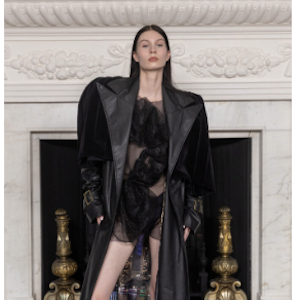The Art Of Leather
By Fleur Chattillon
It’s a strong, flexible, durable material, used and practised for more than 7.000 years. Clothing, footwear, furniture, tools sports equipment and handbags; of course, we are talking about leather. It became an elemental product in our daily existence, at first mainly used for practical purposes but eventually for luxurious and decorative things. It’s not an easy process to manufacture leather and involves several fundamental steps and stages, but that makes it unique. But what happens when the craft blossoms even more and designers take it to a whole new level? Find out more in The Art Of Leather.
The leather manufacturing process is divided into three fundamental subprocesses: preparatory stages, tanning, and crusting. A further subprocess, finishing, can be added to the leather process sequence, but not all leathers receive finishing.
A lot of big luxurious brands are famous for their use of leather such as Louis Vuitton, Hermes, Channel, Dior and Loewe and so on. Specifically manufacturing designer handbags, many started In the luggage world. The very best of the best are making exclusive and refreshing crafted leather goods, often taking this art to new levels.
Spain, a long-time leather producer, is known for its luxury leader Tissa Fontaneda, one of the most distinctive and intriguing luxury handbag brands, who alongside dedicated craftsmen have created a new style of leather called ‘The bubble effect’ and they have built a whole collection of desired skinned items in this specialised material exclusive to them.
The interesting process of making these handbags and accessories comes from their long history and expertise.
Born in Munich, Germany, in 1965, Tissa Fontaneda spent the majority of her life abroad. After graduating from the University of Turin, Italy, with a PhD in Literature and Philosophy, she then moved to Paris to pursue her teenage dream of working in fashion. At Daniel Swarovski, Tissa began her career as a design assistant to Rosemarie Le Gallais and Hervé Leger. Tissa relocated to Madrid five years later and then joined the Spanish luxury leather brand Loewe to develop the internationally renowned designer Thierry Mugler with his handbag collections.
Portrait of Tissa Fontaneda
At Loewe, Tissa learned about leather and handbag manufacturing from some of the world’s greatest European artisans. When Loewe was acquired by the LVMH group, Tissa was invited by President Yves Carcelle to be the Head of Production for Loewe accessories under Narciso Rodriguez.
In addition to Loewe, she also worked with several other brands including Cartier, Dunhill, Connolly and Louis Vuitton. Driven by a strong desire to merge her creative vision with her expertise in the world of luxury accessories, Tissa launched her eponymous label – “classic luxury with a modern twist” – in 2010.
The brand grew pretty quickly and Tissa’s inspired designs have achieved widespread recognition throughout the world. But how do you go from a simple piece of leather to a bubbly handbag in the most colourful tints?


Well, first of all, Tissa has a fruitful and blossoming relationship with the manufacturers she works with, most of whom have been manufacturing her bags since the brand was born in 2010. These manufacturers have developed and improved their techniques to a point of near perfection, reflecting the nobility and exquisiteness of the leather in all of Tissa’s products.


The “bubble” effect is the signature of all Tissa Fontaneda products and has become synonymous with her name. Achieved through a very particular technique of steaming and contraction, the “bubble” effect is the outcome of an extremely complex artisanal process that can even take up to ten hours. So it’s not just making a handbag or accessory anymore, it becomes a real art.


Each individual skin reacts differently, colour differences and imperfections are, therefore, a natural consequence of the production process. This is very common with the use of leather. You could say these small imperfections make these bags unique, and they specifically reflect the special style of artistry behind each item.


All Tissa Fontaneda handbags and accessories are made in Madrid and Ubrique – a small town located in the south of Spain, known worldwide for its flourishing leather industry.
Bubbly, in bright and soft colours and every shape or size, these handbags flourish everywhere and take their exclusive place in a world full of leather goods. You could say she took The Art Of Leather to a whole new level and made the craft blossom in a new way.
For more information about the brand Tissa Fontaneda and to purchase items of the 2023 collection go here
If you enjoyed reading The Art Of Leather why not read 24-hour Salone?
.Cent London, Be inspired; Get involved.







